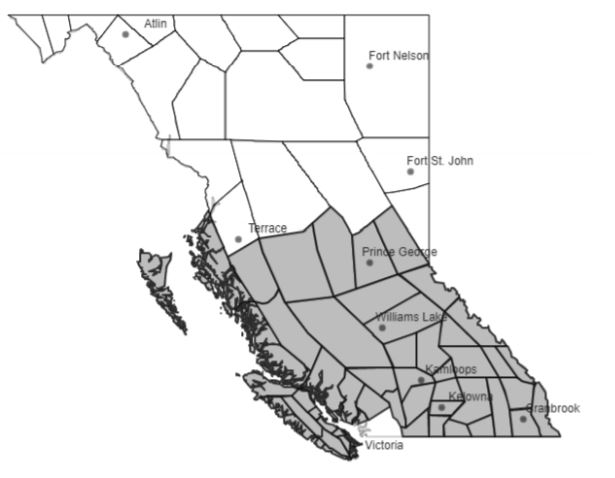
The smoky skies bulletin for all of Vancouver Island and other parts of British Columbia has been extended yet again due to the wildfire smoke coming from the United States.
The regions of B.C. highlighted on the map below, including all of Vancouver Island and the Southern Gulf Islands, are being impacted or are likely to be impacted by wildfire smoke over the next 24 to 72 hours.
According to the province, very heavy smoke from the United States is continuing to have “extensive impacts” across the southern third of the province with lesser impacts extending into the mid-regions of the province.
Smoky conditions are expected to be variable but persist in areas currently being impacted until Thursday, Sept. 17.

The smoky skies bulletin map on Sept. 14, 2020 (Province of BC)
The BC Air Quality Health Index rates nearly everywhere in southern and central part of Vancouver Island, as well as most of southern B.C., province as having “very high” health risks, as of Monday afternoon.
The province says during a wildfire, smoke conditions can change quickly over short distances and can vary considerably hour-by-hour.
People with pre-existing health conditions, respiratory infections such as COVID-19, older adults, pregnant women and infants, children, and sensitive individuals are more likely to experience health effects from smoke exposure.
During smoky conditions people should:
- Stop or reduce your activity level if breathing becomes uncomfortable or you feel
unwell. - Stay cool and drink plenty of fluids.
- If you have asthma or other chronic illness, carry any rescue (fast-acting) medi cations with you at all times and activate your personal care plan that has been designed with your family physician.
- Make sure that children and others who cannot care for themselves follow the
same advice.
The province also says people respond differently to smoke. Mild irritation and discomfort are common
and usually disappear when the smoke clears. Exposure to wildfire smoke and the virus that causes COVID-19 can both result in respiratory symptoms such as a dry cough, sore throat, or difficulty breathing.
People can use the BC COVID-19 Self-Assessment Tool to help determine if they need further assessment or testing for COVID-19.
If you are unsure whether you need medical care, call HealthLink BC at 811. If you are experiencing difficulty in breathing, chest pain or discomfort, or a severe cough, contact your health care provider, walk-in clinic, or emergency department. If you are having a medical emergency, call 911.
Here are the following tips from the province to reduce smoke exposure:
- Smoke levels may be lower indoors but will still be elevated, so stay aware of your symptoms even when you are indoors.
- Running a commercially available HEPA (high efficiency particulate air) filter can improve indoor air quality in the room where the device is located.
- If you have a forced air heating/cooling system in your home, it may help to change the filter and set the fan to run continuously.
- Reduce indoor air pollution sources such as smoking, burning incense, and frying foods.
- If travelling in a car with air conditioning, keep the windows up and the ventilation set to recirculate.
- If you are very sensitive to smoke, consider moving to another location with cleaner air, but be aware that conditions can change rapidly.
- Maintaining good overall health is a good way to prevent health effects resulting from short-term exposure to air pollution.




